The Lost Art Colony of Greenwich, Connecticut
Find out how you can visit the picturesque site that attracted artists and writers from NYC!


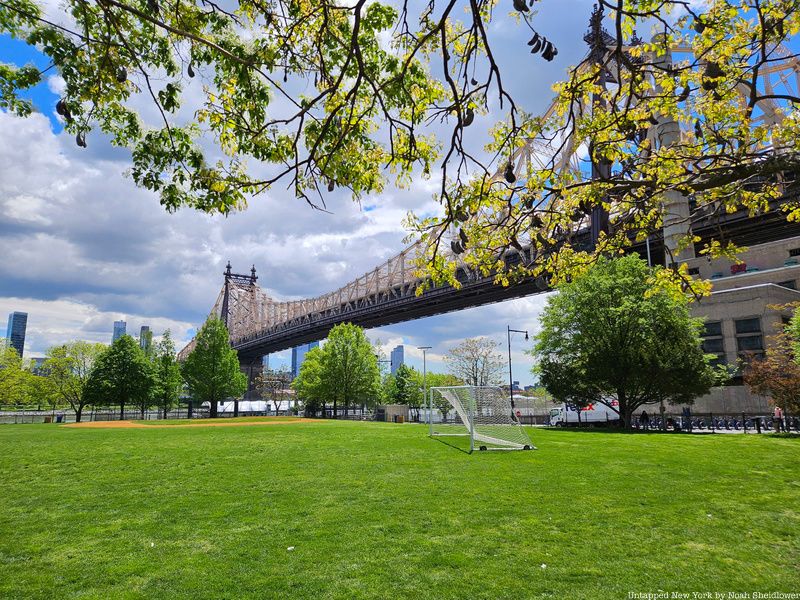
Untapped New York has written a lot of articles on New York City’s islands, both abandoned and in use. While the city’s mainland is filled with cool history and things to do, its islands, such as North Brother Island, Hart Island, Governors Island, and Rikers Island, also have some intriguing sights. Now, it’s time to rediscover New York City’s Roosevelt Island – a residential, two-mile-long island packed with interesting secrets.

Though Roosevelt Island is now named after President Franklin Delano Roosevelt, people have called the island quite a few different things before. The Lenape tribe, who first inhabited the island, called it “Minnehanonck.” According to the New York Times, this name is commonly thought to be translated as “Long Island,” or “It’s nice to be on the island.” When the Dutch purchased Roosevelt Island from the Native Americans in 1637, they renamed it “Varken Eylandt,” or “Hogs Island,” for all the hogs raised there. A little while later, a British captain named John Manning lived on the island in shame after surrendering New York to the Dutch, so it became known as “Manning’s Island.”
The name changed to “Blackwell’s Island” in 1686 when Captain Manning’s stepdaughter inherited the island and married Robert Blackwell. Under this namesake, it became home to institutions such as a prison, lunatic asylum, and a smallpox hospital, all of which will be discussed later in this list. In 1921, the city renamed the island “Welfare Island” when it started reforming the area, establishing hospitals. Finally, in 1973 it became “Roosevelt Island,” after Franklin Delano Roosevelt.

This is probably one you didn’t expect: Roosevelt Island has the only Automated Vacuum Collection System (AVAC) to serve a residential complex in the entire nation. An AVAC is essentially a high-speed waste transportation system that uses underground pneumatic tubes to a collection station, where it is compacted and sealed in containers. The AVAC moves 5.8 tons of trash per day.
Operated by the New York City Department of Sanitation, it is only one of two such systems in the United States at this scale (the other being at Disney World). For nearly half a century, the island’s residential trash has been handled without curbside truck pickup, limiting the need for workers to be out handling the garbage. The waste stays in an inlet until a sensor notes the garbage has reached a certain level. The AVAC system automatically opens the valve and sucks garbage at 60 to 70 miles per hour through 20-inch underground tubes to the central facility.
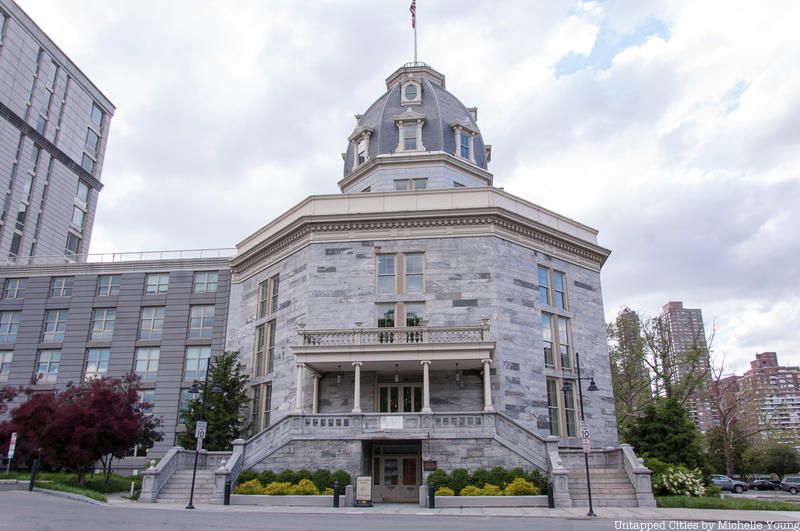
Many have probably heard of Nellie Bly, a woman who pretended to be insane in order to write a breakthrough investigative piece on the cruelty of the Women’s Lunatic Asylum on Blackwell’s Island. This asylum was run inside Octagon Building which still stands on Roosevelt Island. The asylum opened in 1838, and rumors quickly spread about its brutal abuse of the inmates. In her expose, “Ten Days in a Madhouse,” Bly called the asylum a “human rat-trap” with staff who “choked, beat and harassed patients.”
The asylum moved to Ward’s Island a little while later, so this building became the Metropolitan Hospital, which then moved to Harlem in the 1950s. The asylum’s original octagon still stands as a classy apartment complex near a beautiful community garden, quite a contrast to what it used to be. Visitors are generally welcome to enter the octagon, which serves as the lobby, and look at the old photographs on display.

On the island, Bly’s legacy is remembered with a public art piece called The Girl Puzzle. This piece consist of a series of faces that depict women who have endured hardship in their lives and were made stronger because of it. In the center of the monument is a Bly’s face cast in silver bronze. Bly’s face is flanked by the four bronze faces meant to represent Asian American, Black, young, older, and queer women, each rendered in partial sections to appear like giant puzzle pieces.

If the lunatic asylum and prison weren’t enough, another former, creepy institution on Roosevelt Island can be added to the list: a smallpox hospital. By the end of the 1800s, it was common to isolate patients suffering from contagious diseases like smallpox on islands, like North Brother Island, Hoffman and Swinburne Islands, and of course, Blackwell’s Island. The island’s Gothic Revival-style Renwick Smallpox Hospital was designed by James Renwick Jr. (who designed St. Patrick’s Cathedral), built using labor from the lunatic asylum and completed in 1856.
It functioned for 19 years and treated about 7,000 patients. Many of these were impoverished immigrants or Union soldiers who needed curing. In 1875, the hospital moved to North Brother Island when it became too crowded, but the original building remains today and is the “only landmarked ruin” in New York City. During the construction of FDR Four Freedoms Park, the organization behind the park hoped to use the hospital as a visitor center, but funds and interest petered out after initial stabilization. Recently released is the new short film Unforgotten: Renwick Ruin by artist Aaron Asis, Untapped New York’s Artist in Residence. Asis and his team at Green Ghost Studios were given special access inside the abandoned structure, and the film showcases perspectives of the Renwick ruin that are rarely seen by the public.
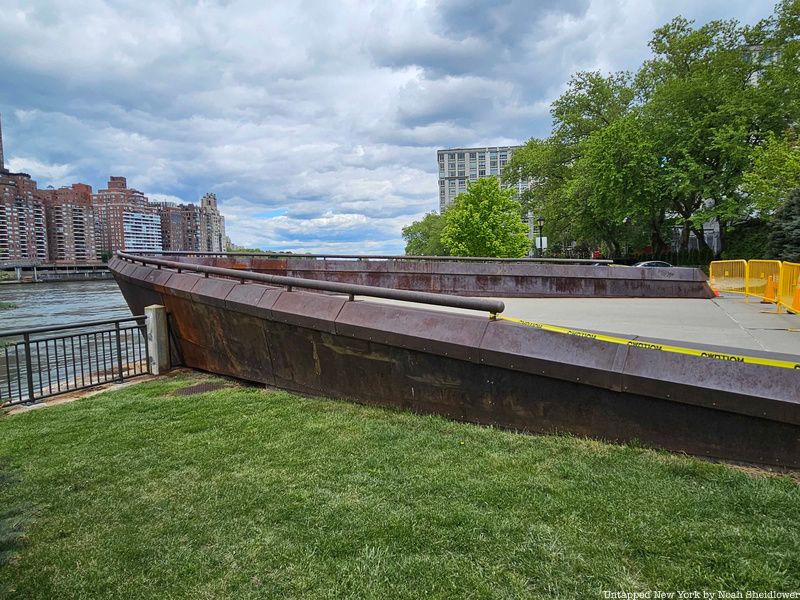
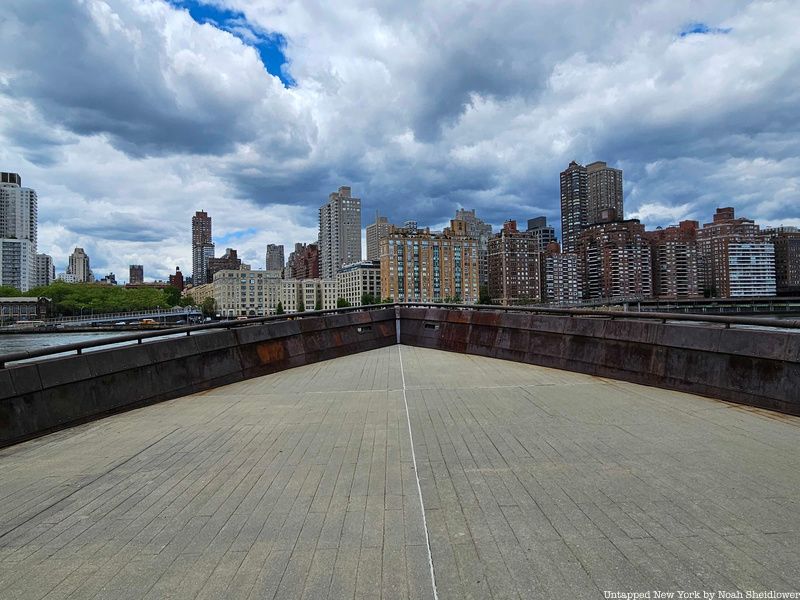
It might seem like the large boat prow sticking out the side of Octagon Park is some intriguing, ancient remnant of a ship washed ashore. However, turns out it’s an art project. There actually used to be a boat landing in this location, and in 1997 a performance stage and observation platform were built in the shape of a boat prow.
According to The New York Times, there are only two “nautical embellishments.” The Times writes of “Two small slots near the tip–presumably for imaginary anchor chains… though a few heavy mooring posts have been placed nearby.” The prow has become somewhat of a popular graffiti spot, though it is regularly cleaned and maintained.
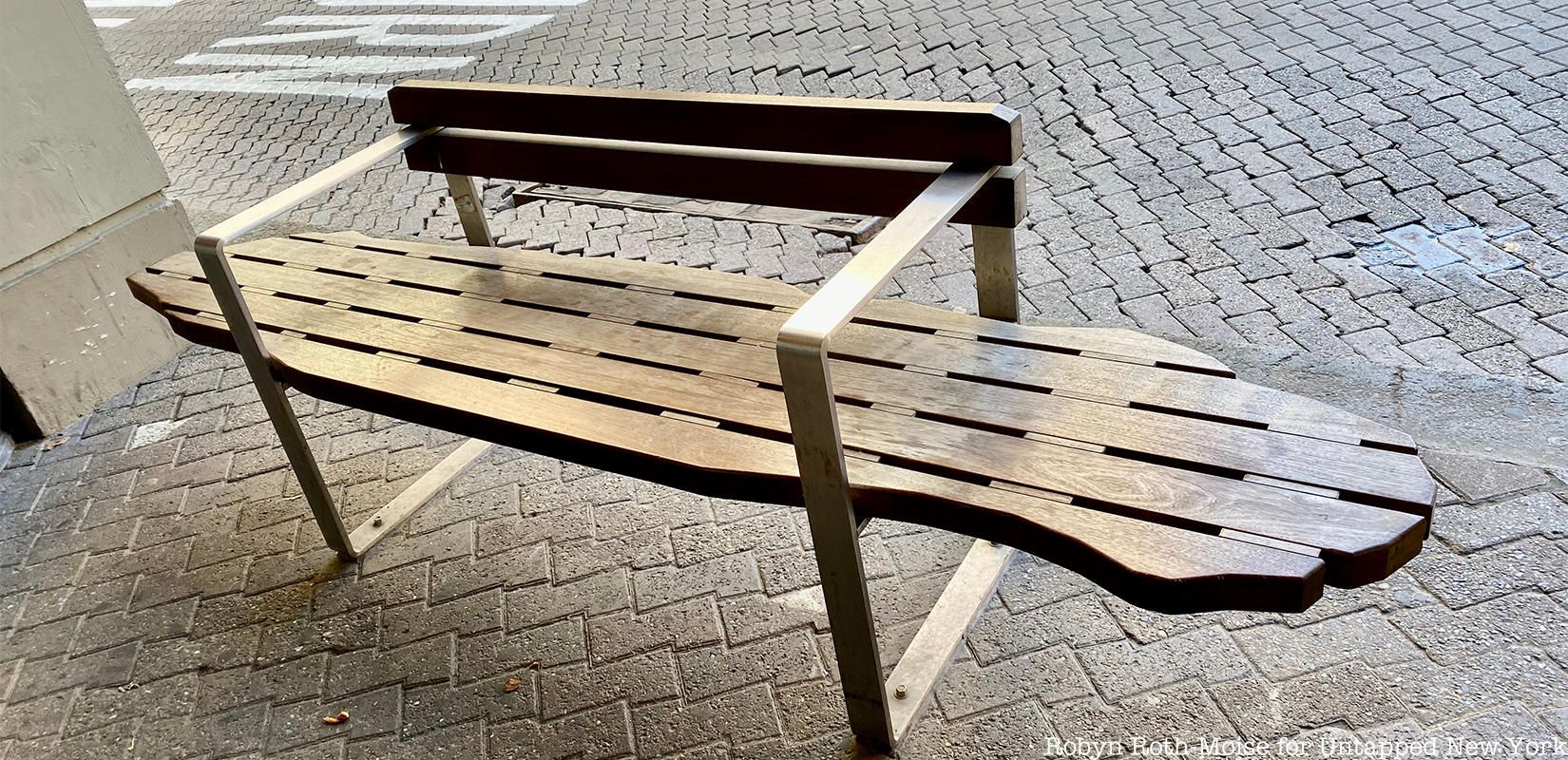
Along Main Street, at The Shops on Main, you’ll find wooden benches that are shaped like Roosevelt Island. On a tour of the island back in 2020, David Kramer, President of The Hudson Companies, the developer behind numerous projects on Roosevelt Island, including Riverwalk and The House at Cornell Tech, told Untapped New York, “the impetus behind the design was to be, well, fun and terrific. There’s a history of interesting, design-oriented, whimsical details on Roosevelt Island.”
Jonathan Marvel of Marvel Architects said the mahogany benches with stainless steel support are a “signature moment” and that the design team “didn’t want to do a normal New York City park bench because we’d be losing an opportunity to make something distinctive.” The long slender shaped of the island made it perfect for a bench seat. Other benches on the island are in the style of the 1939-40 World’s Fair benches, originally designed for Central Park. Learn more about the Roosevelt Island-shaped benches here!

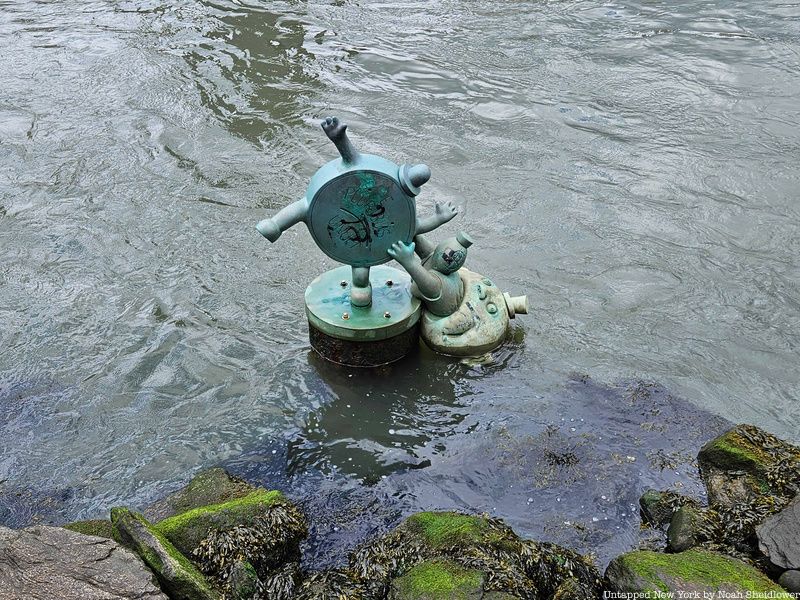
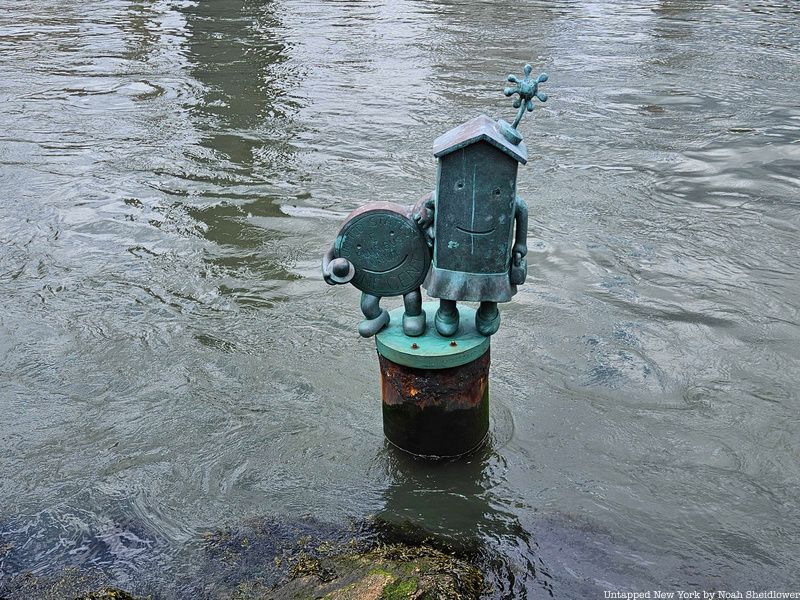
If you were to stroll along the western promenade of Roosevelt Island, you might want to peer over into the East River: there are small, funny-looking, green statues in the water. These quirky sculptures were created by Tom Otterness in 1996, and the installation as a whole is called “The Marriage of Real Estate and Money.”
The series consists of three bronze sculptures by the Brooklyn-based artist, whose works often include large pennies and other money caricatures. He is also known for “Life Underground” at the 14th Street subway station, which depicts various scenes including an alligator reaching out from underneath a manhole cover to snatch a man for dinner. The three Roosevelt Island sculptures depict respectively, a coin attacked by a moneybag coming out of the mouth of a man, a house wearing a skirt attacked by a money-inspired lobster, and a house and coin getting married.


The adorable Visitors Center tucked at the base of Queensboro Bridge has a fascinating history, and secrets of its own. The tiny structure dates back to 1909 when the Queensboro Bridge had a trolley line that went to Astoria, Flushing, College Point, Corona, Steinway and Queens Boulevard. There were originally five kiosks located between the inbound and outbound lower level roads between 59th and 60th Street. After the last trolley ran on this line in 1957, three of the five kiosks were demolished. One was moved to the Brooklyn Children’s Museum in Crown Heights where it functioned as the entrance to the museum.
When the museum was redesigned in 2003, the Roosevelt Island Historical Society (RIHS) wanted to bring the kiosk back to the Manhattan side of the bridge. After a four year effort, the kiosk opened in 2007. It is run by the Roosevelt Island Historical Society today and serves as resource point for those looking for more information about the island. Inside, look up and you’ll find Guastavino tiling, the familiar herringbone patterened arch system found in Grand Central Terminal, Ellis Island, the decommissioned City Hall subway station, and many more places. Learn more about the Visitors Center here!

The bright red tramway system carrying commuters from Manhattan to Roosevelt Island and back was established in 1976 as a temporary means of transportation for island residents while they awaited the completion of the island’s subway link. By this time, the trolley tracks connecting Roosevelt Island with mainly Manhattan had been slowly deteriorating beyond repair. However, by the time the link was there, the tramway had already become an integral mode of transportation, so it continued to operate and became permanent.
The tram was built by Swiss company Von Roll, though the current tram is the second iteration; the tramway underwent a major renovation in 2010 that added a dual-hall system and new cars. Today it remains a crucial part of New York City’s transit system which has carried well over 26 million passengers, serving as North America’s first aerial tramway used for commuter transit. The tram was notably the last mode of transportation in New York City to adopt the MetroCard, doing so in 2003.


The FDR Four Freedoms Park, which was finished in 2012, took 40 years to finally complete. Over the years, economic crises and political sensibilities halted progress on the park until architect Gina Pollara revived the project. As such, Roosevelt Island’s Four Freedoms Park is the only establishment designed by Louis Kahn in New York City. The city commissioned architect Louis Kahn for the memorial, which was his last major work before his death in 1974. Kahn died of a heart attack in Penn Station, with a final rendering of his completed design for Four Freedoms Park in his briefcase at the time.
All materials for the memorial were shipped in via barges, which were loaded up in New Jersey and sent down the East River. An excerpt of Roosevelt’s 1941 State of the Union speech outlining his Four Freedoms is inscribed on the back of the stone frame that holds up his bust, Each granite paving stone is a cube and measures four feet by four feet by four feet. Four Freedoms Park also neighbors a cat sanctuary just to the north inside Southpoint Park, At the opening ceremony, Governor Cuomo said the park was a testament to Louis Kahn, whose design lay “dormant for years but could be picked up and be as vital and current as it was when he designed it.”
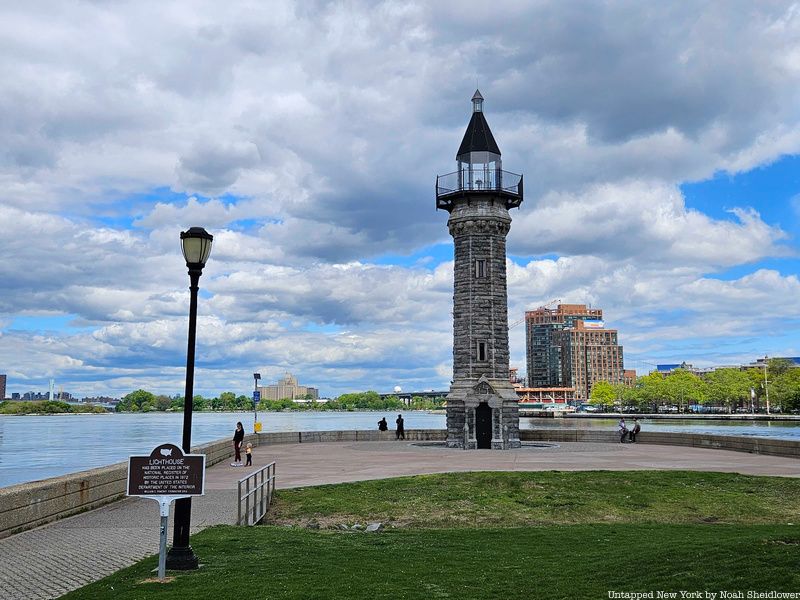
Though the island is now residential and a tourist attraction, there used to be a penitentiary on the island. The city once used it as a place for “undesirable” people. The main building was completed in 1832 and eventually had a north wing when Bellevue Hospital was divided and sent some of its inmates to Blackwell’s Island.
The penitentiary housed around 7,000 inmates, all of whom had to perform daily labor. It contained 221 cells, most of which were filled with minor offenders. The Blackwell’s Workhouse was a punishment center for many “drunks and disorderlies” who were assigned to workhouse shops or other institutions. Convict labor produced institutions on the island including the Charity Hospital, Penitentiary, Alms House, Hospital for Incurables, Workhouse, and Asylum for the Insane. It closed in 1936, shortly after Rikers Island opened.
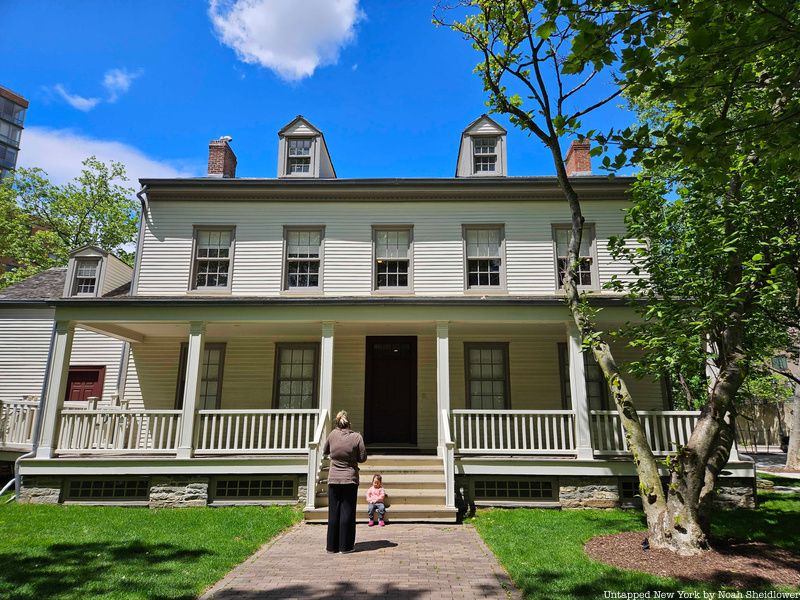
A descendant of Robert Blackwell, James Blackwell, built a house called the Blackwell House, now on Main Street, in about 1796. When the city bought Blackwell’s Island, the island became less agricultural and more institutional. When a penitentiary was erected in 1829, the wooden house became a residential place for institutional administrators. The house was abandoned during the 1900s and restored in the early 1970s.
In addition to being one of the few New York farmhouses from the period immediately following the Revolutionary War, it is also the only surviving building on Roosevelt Island from the time period when the island was still private property. It was added to the National Register of Historic Places in 1972.

The Delacorte Fountain was dedicated in 1968 by George T. Delacorte, who wanted New York to have an equivalent to Switzerland’s Jet D’Eau. It sprayed East River water hundreds of feet into the air across from the United Nations on the southern edge of Roosevelt Island. However, the New York Times reported in 1987 that the city’s Parks Commissioner had fears that “liquid waste was being flung 400 feet in the eyes and faces of people who lived on Sutton Place.”
In response to this, the water was chlorinated, which lowered its height to 240 feet. During the later drought years, people worried the fountain would represent overconsumption of water, so it was turned off. In 1985, the powerful streams of water washed off the topsoil from some newly planted trees and crushed a car roof. The next year, the geyser stopped working.
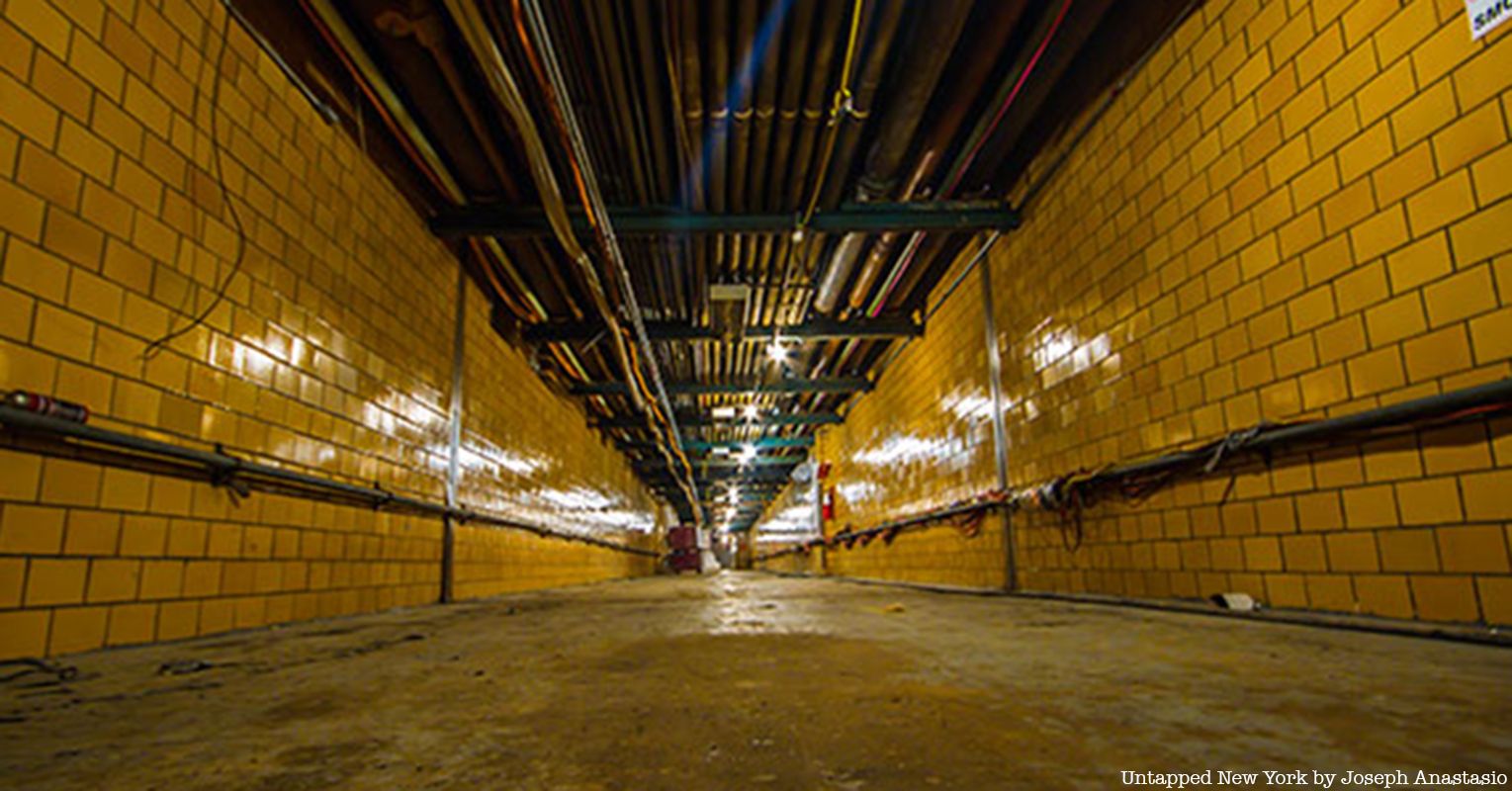
Demolished in 2014, Goldwater Hospital had a long basement-level tunnel that formed a spine below the hospital’s six buildings. The tunnel connected the hospital to a steam-generating plant that still stands. Here’s an image of the tunnel, from our series on NYC’s secret tunnels taken by LTVSquad, who used it to access all of the buildings, which were destroyed to be replaced by the Cornell NYC Tech Campus.
Next, check out 8 Abandoned Islands Near NYC and 6 Abandoned Asylums and Hospitals in the NYC Region
This article was written by Stephanie Geier and updated by Noah Sheidlower and Nicole Saraniero
Subscribe to our newsletter